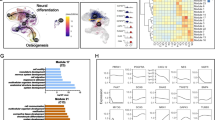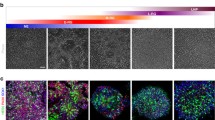Abstract
Recent studies have shown that neural crest-derived progenitor cells can be found in diverse mammalian tissues including tissues that were not previously shown to contain neural crest derivatives, such as bone marrow. The identification of those "new" neural crest-derived progenitor cells opens new strategies for developing autologous cell replacement therapies in regenerative medicine. However, their potential use is still a challenge as only few neural crest-derived progenitor cells were found in those new accessible locations. In this study, we developed a protocol, based on wnt1 and BMP2 effects, to enrich neural crest-derived cells from adult bone marrow. Those two factors are known to maintain and stimulate the proliferation of embryonic neural crest stem cells, however, their effects have never been characterized on neural crest cells isolated from adult tissues. Using multiple strategies from microarray to 2D-DIGE proteomic analyses, we characterized those recruited neural crest-derived cells, defining their identity and their differentiating abilities.






Similar content being viewed by others
Abbreviations
- BMP:
-
Bone morphogenic proteins
- BMSC:
-
Bone marrow stromal cells
- ES:
-
Embryonic stem cells
- GFAP:
-
Glial fibrillary acidic protein
- MSC:
-
Mesenchymal stem cells
- NCC:
-
Neural crest cells
- NCSC:
-
Neural crest stem cells
- NSC:
-
Neural stem cells
References
Le Douarin NM, Ziller C, Couly GF (1993) Patterning of neural crest derivatives in the avian embryo: in vivo and in vitro studies. Dev Biol 159:24–49
Baker CV, Bronner-Fraser M, Le Douarin NM, Teillet MA (1997) Early- and late-migrating cranial neural crest cell populations have equivalent developmental potential in vivo. Development 124:3077–3087
Teng L, Labosky PA (2006) Neural crest stem cells. Adv Exp Med Biol 589:206–212
Stemple DL, Anderson DJ (1992) Isolation of a stem cell for neurons and glia from the mammalian neural crest. Cell 71:973–985
Sauka-Spengler T, Bronner-Fraser M (2006) Development and evolution of the migratory neural crest: a gene regulatory perspective. Curr Opin Genet Dev 16:360–366
Shah NM, Groves AK, Anderson DJ (1996) Alternative neural crest cell fates are instructively promoted by TGFbeta superfamily members. Cell 85:331–343
Shah NM, Marchionni MA, Isaacs I, Stroobant P, Anderson DJ (1994) Glial growth factor restricts mammalian neural crest stem cells to a glial fate. Cell 77:349–360
Morrison SJ, Perez SE, Qiao Z, Verdi JM, Hicks C, Weinmaster G, Anderson DJ (2000) Transient Notch activation initiates an irreversible switch from neurogenesis to gliogenesis by neural crest stem cells. Cell 101:499–510
Sommer L (2006) Growth factors regulating neural crest cell fate decisions. Adv Exp Med Biol 589:197–205
Sieber-Blum M, Grim M (2004) The adult hair follicle: cradle for pluripotent neural crest stem cells. Birth Defects Res C Embryo Today 72:162–172
Wong CE, Paratore C, Dours-Zimmermann MT, Rochat A, Pietri T, Suter U, Zimmermann DR, Dufour S, Thiery JP, Meijer D, Beermann F, Barrandon Y, Sommer L (2006) Neural crest-derived cells with stem cell features can be traced back to multiple lineages in the adult skin. J Cell Biol 175:1005–1015
Nagoshi N, Shibata S, Kubota Y, Nakamura M, Nagai Y, Satoh E, Morikawa S, Okada Y, Mabuchi Y, Katoh H, Okada S, Fukuda K, Suda T, Matsuzaki Y, Toyama Y, Okano H (2008) Ontogeny and multipotency of neural crest-derived stem cells in mouse bone marrow, dorsal root ganglia, and whisker pad. Cell Stem Cell 2:392–403
Brault V, Moore R, Kutsch S, Ishibashi M, Rowitch DH, McMahon AP, Sommer L, Boussadia O, Kemler R (2001) Inactivation of the beta-catenin gene by Wnt1-Cre-mediated deletion results in dramatic brain malformation and failure of craniofacial development. Development 128:1253–1264
Lee HY, Kleber M, Hari L, Brault V, Suter U, Taketo MM, Kemler R, Sommer L (2004) Instructive role of Wnt/beta-catenin in sensory fate specification in neural crest stem cells. Science 303:1020–1023
Lefebvre PP, Rogister B, Delree P, Leprince P, Selak I, Moonen G (1987) Potassium-induced release of neuronotoxic activity by astrocytes. Brain Res 413:120–128
Okabe M, Ikawa M, Kominami K (1997) “Green mice” as a source of ubiquitous green cells. FEBS Lett 407:313–319
Wislet-Gendebien S, Hans G, Leprince P, Rigo JM, Moonen G, Rogister B (2005) Plasticity of cultured mesenchymal stem cells: switch from nestin-positive to excitable neuron-like phenotype. Stem Cells 23:392–402
Kléber M, Lee HY, Wurdak H, Buchstaller J, Riccomagno MM, Ittner LM, Suter U, Epstein DJ, Sommer L (2005) Neural crest stem cell maintenance by combinatorial Wnt and BMP signaling. J Cell Biol 169(2):309–320
Wislet-Gendebien S, Leprince P, Moonen G, Rogister B (2003) Regulation of neural markers nestin and GFAP expression by cultivated bone marrow stromal cells. J Cell Sci 116:3295–3302
Wautier F, Wislet-Gendebien S, Chanas G, Rogister B, Leprince P (2007) Regulation of nestin expression by thrombin and cell density in cultures of bone mesenchymal stem cells and radial glial cells. BMC Neurosci 8:104
Peng H, Kolb R, Kennedy JE, Zheng J (2007) Differential expression of CXCL12 and CXCR4 during human fetal neural progenitor cell differentiation. J Neuroimmune Pharmacol 2:251–258
Martinsen BJ, Bronner-Fraser M (1998) Neural crest specification regulated by the helix-loop-helix repressor Id2. Science 281:988–991
Koblar SA, Murphy M, Barrett GL, Underhill A, Gros P, Bartlett PF (1999) Pax-3 regulates neurogenesis in neural crest-derived precursor cells. J Neurosci Res 56:518–530
Estivill-Torrus G, Pearson H, van Heyningen V, Price DJ, Rashbass P (2002) Pax6 is required to regulate the cell cycle and the rate of progression from symmetrical to asymmetrical division in mammalian cortical progenitors. Development 129:455–466
Faedo A, Quinn JC, Stoney P, Long JE, Dye C, Zollo M, Rubenstein JL, Price DJ, Bulfone A (2004) Identification and characterization of a novel transcript down-regulated in Dlx1/Dlx2 and up-regulated in Pax6 mutant telencephalon. Dev Dyn 231:614–620
Corbin JG, Rutlin M, Gaiano N, Fishell G (2003) Combinatorial function of the homeodomain proteins Nkx2.1 and Gsh2 in ventral telencephalic patterning. Development 130:4895–4906
Fukuda T, Kawano H, Osumi N, Eto K, Kawamura K (2000) Histogenesis of the cerebral cortex in rat fetuses with a mutation in the Pax-6 gene. Brain Res Dev Brain Res 120:65–75
Bolanos JP, Almeida A, Moncada S (2010) Glycolysis: a bioenergetic or a survival pathway? Trends Biochem Sci 35:145–149
Rodriguez R, Rubio R, Masip M, Catalina P, Nieto A, de la Cueva T, Arriero M, San Martin N, de la Cueva E, Balomenos D, Menendez P, Garcia-Castro J (2009) Loss of p53 induces tumorigenesis in p21-deficient mesenchymal stem cells. Neoplasia 11:397–407
Acknowledgments
This work was supported by a grant from the Fonds National de la Recherche Scientifique (FNRS) of Belgium, by a grant of the Action de Recherche Concertée de la Communauté Française de Belgique, and by the Belgian League against Multiple Sclerosis associated with Leon Fredericq Foundation. AG is a Marie Curie Host Fellow for Early Stage Research Training, EURON 020589 within the 6th FP of the EU, Marie Curie Actions, Human Resources and Mobility. SWG is a Postdoctoral researcher and PL is a Research Associate of the FNRS. Normalization and data filtering were performed using BRB-ArrayTools software version 3.8.1 developed by Dr. Richard Simons and BRB-ArrayTools Development Team http://linus.nci.nih.gov./BRB-ArrayTools.html.
Author information
Authors and Affiliations
Corresponding author
Additional information
Electronic supplementary material
Below is the link to the electronic supplementary material.
Table S1
. Gene expression profile comparison between clone 1 and clone 4. 328 genes have been identified as differentially expressed between clone 1 and 4, with a minimum of 2 fold difference
Table S2
. Gene expression profile comparison between clone 1 and NCSC clone (wnt1-CRE/R26R). 3,578 genes have been identified as differentially expressed between clone 1 and 4, with a minimum of 2 fold difference
Table S3
. Gene expression profile comparison between clone 4 and NCSC clone (wnt1-CRE/R26R). 3966 genes have been identified as differentially expressed between clone 4 and NCSC clone, with a minimum of 2 fold difference
Table S4
. Gene expression profile of specific cell type genes: comparison between clone 1 and clone 4
Rights and permissions
About this article
Cite this article
Glejzer, A., Laudet, E., Leprince, P. et al. Wnt1 and BMP2: two factors recruiting multipotent neural crest progenitors isolated from adult bone marrow. Cell. Mol. Life Sci. 68, 2101–2114 (2011). https://doi.org/10.1007/s00018-010-0558-5
Received:
Revised:
Accepted:
Published:
Issue Date:
DOI: https://doi.org/10.1007/s00018-010-0558-5




